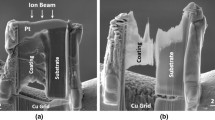Abstract
Untreated bright and dull zinc coatings produced on a hot-dipped-coating pilot line from a zinc bath containing small concentrations of aluminum, antimony, and lead were examined with a scanning Auger microprobe. The results show that the entire surface of the zinc coating was covered by a very thin, continuous film comprised of aluminum and oxygen. The thickness of this film, of the order of 5 nanometers, was the same for both bright and dull coatings and independent of zinc spangle roughness. Beneath this film the zinc surface contained numerous small precipitates that occupied a considerable portion of the total coating surface area, perhaps as much as 25 pct for some spangles. In all, five distinct types of precipitates were observed in the coatings. Aluminum was common to each type except for one which was essentially pure lead. In the others the principal element combined with aluminum was oxygen in one case, antimony in the second, iron in the third, and zinc in the fourth case. Based on the results of Auger electron spectrometry, these appear to be A12O3, AlSb, one of the aluminum-rich iron-aluminum intermetallic compounds, and the zinc-rich solid solution of zinc in aluminum, respectively. The size of these various precipitate particles tended to be larger and their frequency greater in rough than in smooth spangles.
Similar content being viewed by others
References
D. Jaffrey, J. D. Browne, and T. J. Howard:Metall. Trans. B, 1980, vol. 11B, pp. 631–35.
L. E. Helwig:Proc. Galv. Comm., Zinc Inst. Inc., 1981, vol. 73, pp. 22–51.
M. E. Waitlevertch and J. K. Hurwitz:Appl. Spectros., 1976, vol. 30, pp. 510–15.
L. F. Franks, B. L. Conduti, and D. E. Smith:Proc. Galv. Comm., Zinc Inst. Inc., 1976, vol. 68, pp. 16–21.
Susan Mroczkowski and David Lichtman:J. Vac. Sci. Technol. A, 1985, vol. 3, pp. 1860–65.
Max Hansen:Constitution of Binary Alloys, McGraw-Hill, 1958. 7. Thaddeus B. Massalski, Joanne L. Murray, Lawrence H. Bennett, and Hugh Baker:Binary Alloy Phase Diagrams, ASM, 1986.
V. Leroy:Mater. Sci. Eng., 1980, vol. 42, pp. 289–307.
F. M. Kilbane:Proc. Galv. Comm., Zinc Inst. Inc., 1982, vol. 74, pp. 1–45.
R. Payling and P. D. Mercer:Appl. Surf. Sci., 1985, vol. 22/23, pp. 224–35.
Author information
Authors and Affiliations
Rights and permissions
About this article
Cite this article
Biber, H.E. Scanning auger microprobe study of hot-dipped regular-spangle galvanized steel: Part I. surface composition of As-produced sheet. Metall Trans A 19, 1603–1608 (1988). https://doi.org/10.1007/BF02674035
Received:
Issue Date:
DOI: https://doi.org/10.1007/BF02674035




